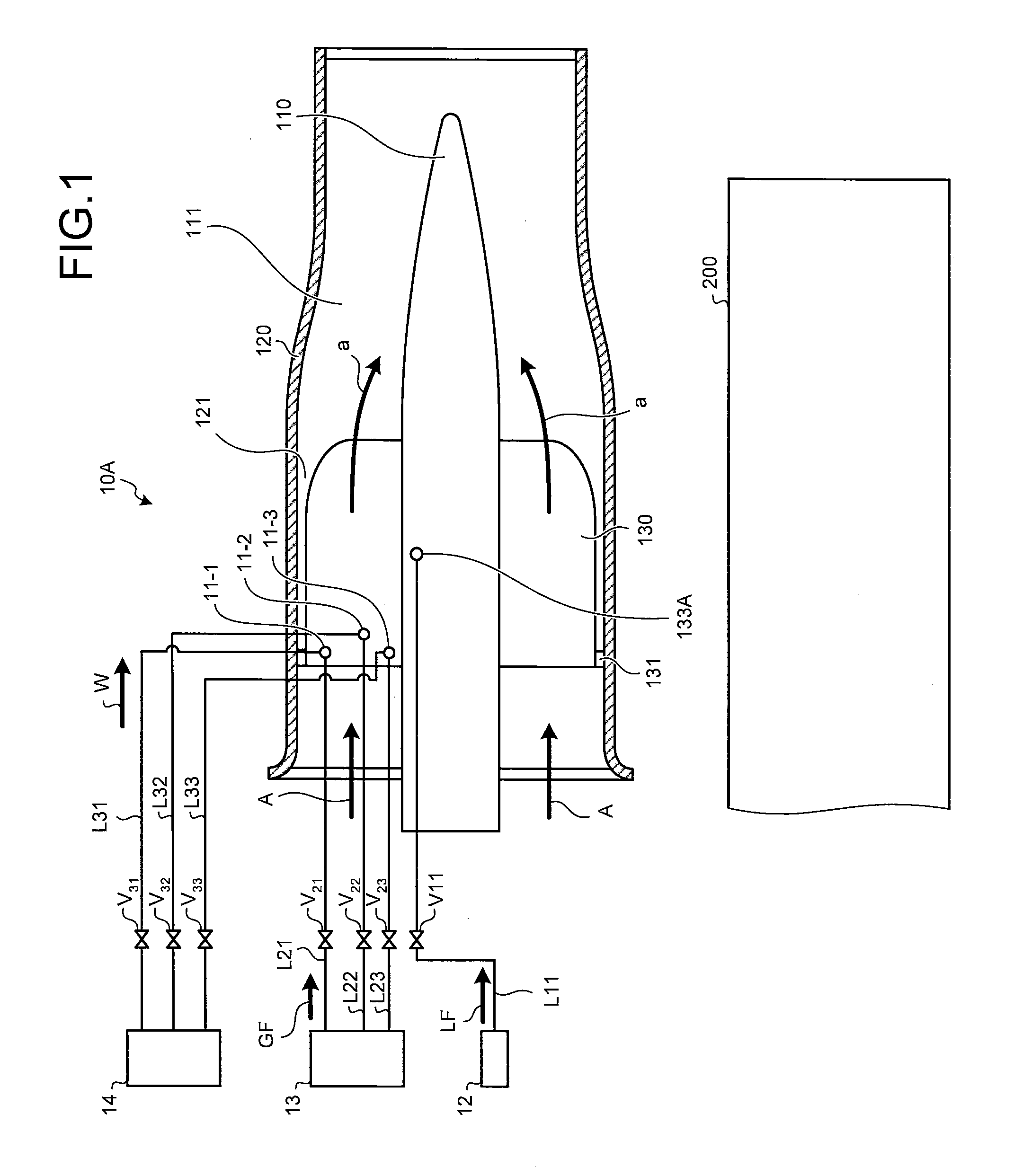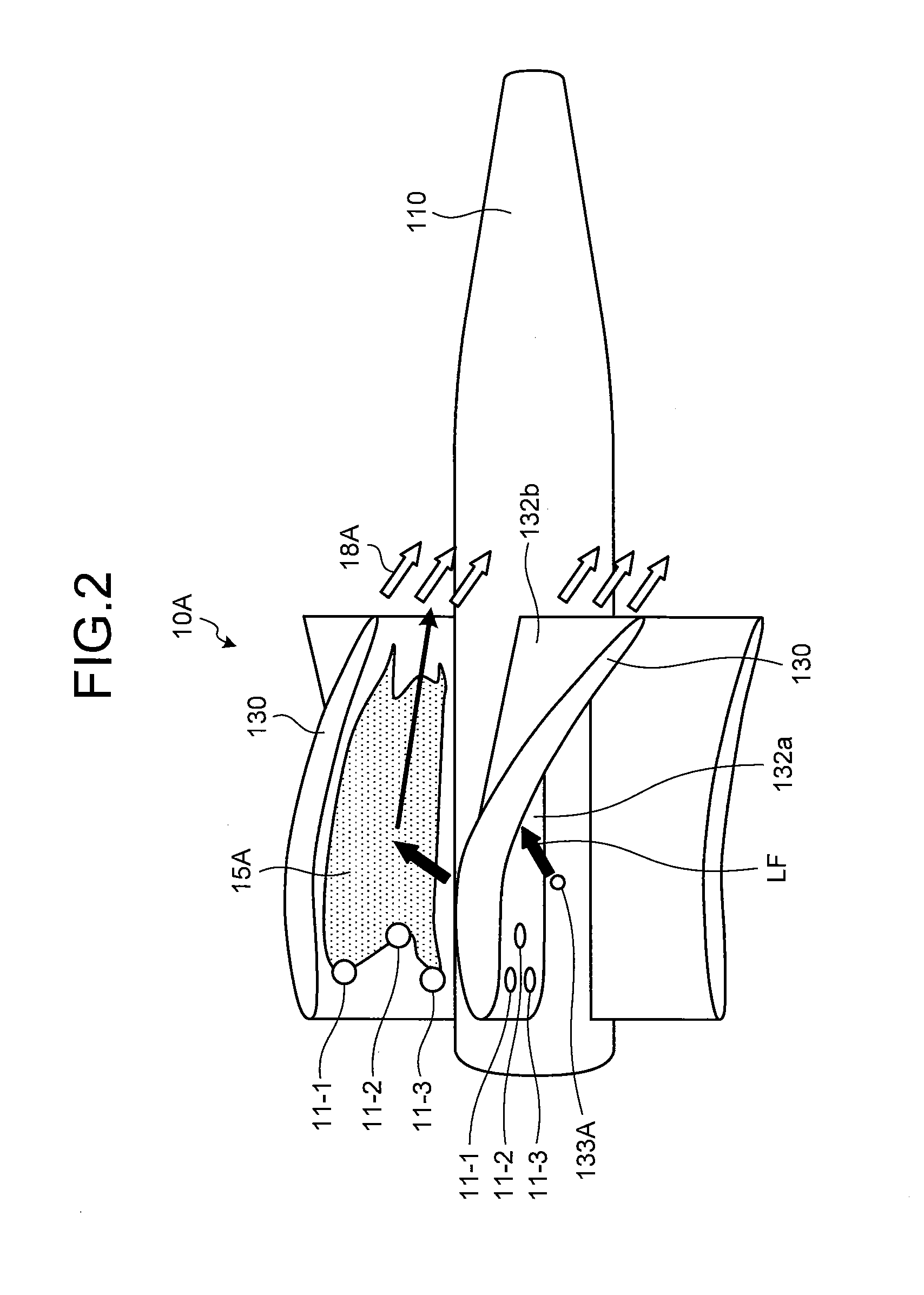Combustion burner
a combustion burner and burner technology, applied in the field of combustion burners, can solve the problems of limited capacity of conventional combustion burners b>100/b>a, difficult to make fuel density uniform in the fuel nozzle, and limited ability to atomize liquid fuel, so as to prevent the formation of carbon deposits, reduce the nox in the combustion field, and prevent the effect of carbon deposi
- Summary
- Abstract
- Description
- Claims
- Application Information
AI Technical Summary
Benefits of technology
Problems solved by technology
Method used
Image
Examples
first embodiment
[0070]A combustion burner according to a first embodiment of the present invention will now be explained with reference to some of the attached drawings.
[0071]FIG. 1 is a schematic of a structure of the combustion burner according to the first embodiment of the present invention.
[0072]In FIG. 1, elements that are the same as those shown in FIGS. 8 to 10 are given the same reference numerals, and redundant explanations thereof are omitted.
[0073]As shown in FIG. 1, a combustion burner 10A according to the present embodiment includes: the fuel nozzle 110; the burner tube 120 surrounding the fuel nozzle 110 to form the air passage 111 between the burner tube 120 and the fuel nozzle 110; the swirler vanes (swirler vanes) 130 arranged in a plurality of positions in the circumferential direction on the external circumferential surface of the fuel nozzle 110, each extending along the axial direction of the fuel nozzle 110, and gradually curving from upstream to downstream of an air that flo...
second embodiment
[0105]A combustion burner according to a second embodiment of the present invention will now be explained with reference to FIG. 4.
[0106]The combustion burner according to the present embodiment has almost the same structure as that of the combustion burner 10A according to the first embodiment shown in FIG. 1; therefore, the same reference numerals are given to the elements that are same as those in the combustion burner 10A shown in FIG. 1, and redundant explanations thereof are omitted.
[0107]In the present embodiment, only the combustion nozzle 110 and the swirler vanes 130 are described and the other elements are omitted. The same can be said in the remaining embodiments.
[0108]FIG. 4 is a schematic of a structure of the combustion burner according to the second embodiment of the present invention.
[0109]As shown in FIG. 4, in a combustion burner 10B according to the present embodiment, the multi-purpose injecting holes 11-1 to 11-3, which are arranged on the vane pressure surface...
third embodiment
[0114]A combustion burner according to a third embodiment of the present invention will now be explained with reference to FIG. 5.
[0115]The combustion burner according to the present embodiment has almost the same structure as that of as the combustion burner 10A according to the first embodiment shown in FIG. 1; therefore, the same reference numerals are given to the elements that are same as those in the combustion burner 10A shown in FIG. 1, and redundant explanations thereof are omitted.
[0116]In the third embodiment, only the combustion nozzle 110 and the swirler vanes 130 are described, and the other elements are omitted.
[0117]FIG. 5 is a schematic of a structure of the combustion burner according to the third embodiment of the present invention.
[0118]As shown in FIG. 5, in a combustion burner 10C according to the present embodiment, the multi-purpose injecting holes 11-1 to 11-3, which are arranged on the vane pressure surface 132a of the swirler vanes 130 in the combustion bu...
PUM
 Login to View More
Login to View More Abstract
Description
Claims
Application Information
 Login to View More
Login to View More - R&D
- Intellectual Property
- Life Sciences
- Materials
- Tech Scout
- Unparalleled Data Quality
- Higher Quality Content
- 60% Fewer Hallucinations
Browse by: Latest US Patents, China's latest patents, Technical Efficacy Thesaurus, Application Domain, Technology Topic, Popular Technical Reports.
© 2025 PatSnap. All rights reserved.Legal|Privacy policy|Modern Slavery Act Transparency Statement|Sitemap|About US| Contact US: help@patsnap.com



